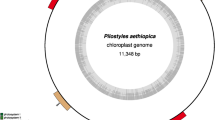Abstract
In the plastome of the obligate root-parasitic plant, Lathraea clandestina, the rbcL gene has been maintained and is expressed, despite the reduced size and gene content of the plastid genome. Some of the plastid genes involved in translation (e. g. transfer RNAs, ribosomal RNAs and ribosomal proteins) have been sequenced and still appear to code for functional ribosomal components. Indeed, the 16S rRNA and rpl20 genes are expressed whilst other necessary tRNA and ribosomal protein-encoding genes have probably been deleted or truncated. Although obtained by PCR, the four rpo genes for Escherichia coli-like plastid encoded RNA polymerase appear to be pseudogenes. Nevertheless, the rbcL gene, with a “–10, –35” prokaryotic-like promoter, is still transcribed. In contrast to photosynthetic plants, rbcL transcripts in Lathraea are larger in their 5′ region and cover the prokaryotic-like promoter. The transcription initiation site is located near the ATG start codon of the atpB pseudogene. Similarity to non-consensus E. coli-like plastid promoters suggests that rbcL transcription is driven by a nuclear-encoded RNA polymerase.
Similar content being viewed by others
Author information
Authors and Affiliations
Additional information
Received: 12 January / 8 July 1998
Rights and permissions
About this article
Cite this article
Lusson, N., Delavault, P. & Thalouarn, P. The rbcL gene from the non-photosynthetic parasite Lathraea clandestina is not transcribed by a plastid-encoded RNA polymerase. Curr Genet 34, 212–215 (1998). https://doi.org/10.1007/s002940050388
Issue Date:
DOI: https://doi.org/10.1007/s002940050388




